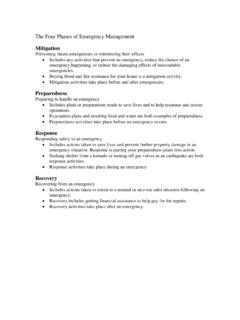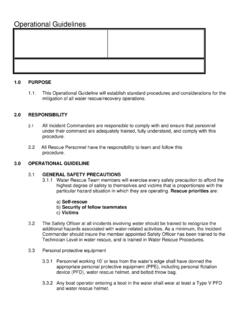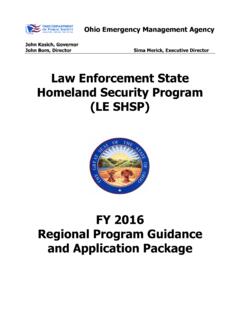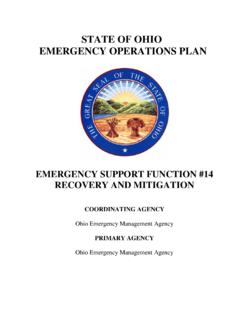Transcription of SECTION 2: HAZARD IDENTIFICATION & RISK ASSESSMENT
1 State of Ohio Enhanced HAZARD Mitigation Plan Rev. January 2011 SECTION 2: HIRA 60 SECTION 2: HAZARD IDENTIFICATION & RISK ASSESSMENT State of Ohio Enhanced HAZARD Mitigation Plan Rev. January 2011 SECTION 2: HIRA 61 HIRA OVERVIEW & HAZARD IDENTIFICATION SUMMARY The State of Ohio is prone to many natural and manmade hazards. Ohio has experienced thousands of HAZARD events, resulting in millions of dollars in losses and casualties, and 46 Presidential disaster declarations.
2 In 2003 as part of an overall effort to reduce future exposure to damages and meet the planning requirements of the DMA 2000, the State of Ohio began the development of the initial HAZARD IDENTIFICATION and Risk ASSESSMENT (HIRA). The HIRA has been subsequently reviewed and approved for the 2008 and 2011 plan updates. This SECTION will cover six separate requirements of the 44 CFR (identifying hazards, profiling HAZARD events, assessing vulnerability by jurisdiction, estimating potential losses by jurisdiction, assessing vulnerability of state facilities, and estimating potential losses of state facilities).
3 The first four of the six requirements are integrated into each HAZARD for which is detailed. The last two (state facility vulnerability ASSESSMENT and loss estimation) are discussed in this SECTION , but specifics are integrated into each HAZARD . The following will provide a more in-depth explanation of these six elements and describe the steps taken to ensure the element was met. Identifying hazards The 44 CFR (c)(2)(i) requires the risk ASSESSMENT include an overview of the type of all natural hazards that can affect the state.
4 This SECTION of the plan presents a list of potential hazards that may likely impact the state. Due to the states northern geographical setting on Lake Erie, it is vulnerable to a wide array of hazards that threaten its communities, businesses, governments and environment. To determine the hazards that pose the greatest threat to the state, the OMPAT (in conjunction with FEMA) developed a list of potential hazards by conducting a review of several key resources, which include: Review of historical data on events that have occurred in the last 40 years; Review of 2003 and 2008 plan data.
5 Collaboration with various agencies who are known experts on different hazards, including the Ohio Departments of Natural Resources, Transportation and Environmental Protection Agency; Review of hazards identified in guidance materials provided by FEMA Region V; and Review of the local mitigation plans. Ohio currently has 101 approved single and multi jurisdictional plans with 2 in progress. One additional Plan was updated and forwarded to FEMA Region V for review and pending approval.
6 The approved plans were used to assess the impacts hazards are having throughout the state. State of Ohio Enhanced HAZARD Mitigation Plan Rev. January 2011 SECTION 2: HIRA 62 Risk ASSESSMENT 44 CFR (c)(2)(i) The risk ASSESSMENT shall include an overview of the location of all natural hazards that can affect the State, including information on previous occurrences of HAZARD events, as well as the probability of future HAZARD events, using maps where appropriate. The risk ASSESSMENT relies upon information about past HAZARD events from published sources such as NOAA, USGS, USACE, Ohio EMA and ODNR, among other agencies.
7 The risk ASSESSMENT SECTION for each HAZARD in this plan includes a description of the location of the HAZARD , past occurrences, and a discussion of probability of future HAZARD events. Vulnerability Analysis by Jurisdiction 44 CFR (c)(2)(ii) The risk ASSESSMENT shall include an overview and analysis of the state s vulnerability to the hazards described in this paragraph (c)(2), based on estimates provided in local risk assessments. The state shall describe vulnerability in terms of the jurisdictions most threatened by the identified hazards, and most vulnerable to damage and loss associated with HAZARD events.
8 The methodology for this SECTION varies by HAZARD due to available data and will be more thoroughly discussed prior to the results of the SECTION for each HAZARD . Improved integration of LHMP data into the state HIRA is an ongoing effort. Since the last State Mitigation Plan revision, Ashland and Adams Counties were the final jurisdictions to complete their first mitigation plans. By April 2010, all counties in the state had a mitigation plan.
9 As local plans start to expire and jurisdictions update their plans, vulnerability information and loss estimation are collected and assembled. As the State HAZARD Analysis Resource and Planning Portal (SHARPP) becomes more functional, this information and other data are compiled, analyzed and evaluated. Many of the local plans use HAZUS-MH or similar programs to analyze vulnerability to the jurisdiction and project estimated losses to structures, critical facilities, commercial enterprise and business interruption.
10 These data are incorporated into the analysis tables in this SECTION of the Plan to provide the most current and accurate risk ASSESSMENT at the State level. By the second quarter of 2011, SHARPP is projected to electronically track and evaluate HAZARD metrics and impact to residential, commercial and critical building stock, as well as damage estimates. Estimating Potential Losses by Jurisdiction 44 CFR (c)(2)(iii) The risk ASSESSMENT shall include an overview and analysis of potential losses to identified structures, based on estimates provided in local risk assessments.







